Warning: longer essay-style post.
David B Anthony in his extraordinary book The Horse, the Wheel, and Language: How the Bronze-age Riders from the Eurasian Steppes Shaped the Modern World tells us that language normally changes so that speakers 1000 years apart cannot understand each other. As an example here is the beginning of the Lord’s Prayer in a conservative, old-fashioned version of Modern Standard English:
- Our Father who is in heaven, blessed be your name
Here it is in Chaucer’s English of 1400:
- Oure fadir that art in heuenes, halwid be thy name
Now try Old English of 1000:
- Fæader ure thu the eart on heofonum, si thin nama gehalgod
When British jurist Sir William Jones arrived in Calcutta to become a member of the Bengal Supreme Court in 1783 he was already famous as a linguist for his translations of medieval Persian poetry amongst other works. At that time he already knew French, German, Latin, Greek, Welsh, Persian, Arabic, Hebrew and Gothic, the earliest written form of German. In order to do his job he decided to tool up on Sanskrit. In 1786 he announced an amazing discovery. Latin, Greek and Sanskrit stemmed from the same original language. Just had to be. He also found that Celtic, Gothic and Persian probably came from the same source. Indeed he was right.
Very common words tend not to change much. The word for mother, for example is strikingly similar across a range of languages. Hence we have Middle English moder, Dutch moeder, German Mutter, Irish máthair, Tocharian mācar, Lithuanian mótė, Latin māter, Greek meter, Russian mat’, Persian madar and Sanskrit mātṛ.
The original Proto-Indo-European word has been reconstructed as *méh₂tēr.
You can find more related words here.
In fact all European languages belong to what is now recognised as the Indo-European language group (list here) except Basque, Estonian, Finnish and Magyar (Hungarian).
To the east the Indo-Iranian sub-group includes the majority of modern languages of India including Hindi, Urdu and Bengali.
I’ve included here a chart of the Indo-European language taxonomy from David Anthony’s book:
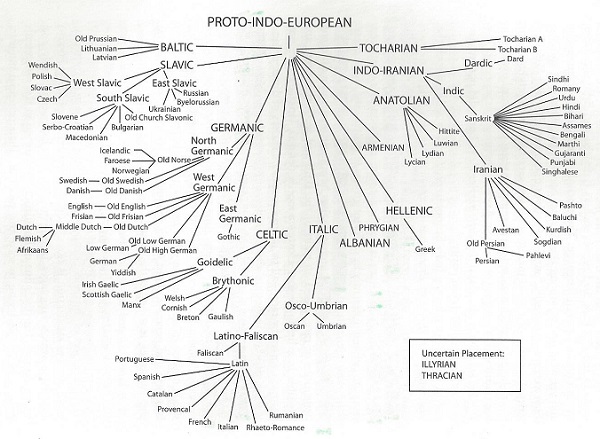
Some of the individual languages are barely legible, but the overall picture is clear.
This Dan Short page provides a useful broad family tree divided into the so-called Centum and Satem groups, divided according to the word for hundred. Neither of these taxonomies helps with the timeline. Anthony gives the following as the best branching diagram, based on the Ringe_Warnow_Taylor (2002) cladistic method:
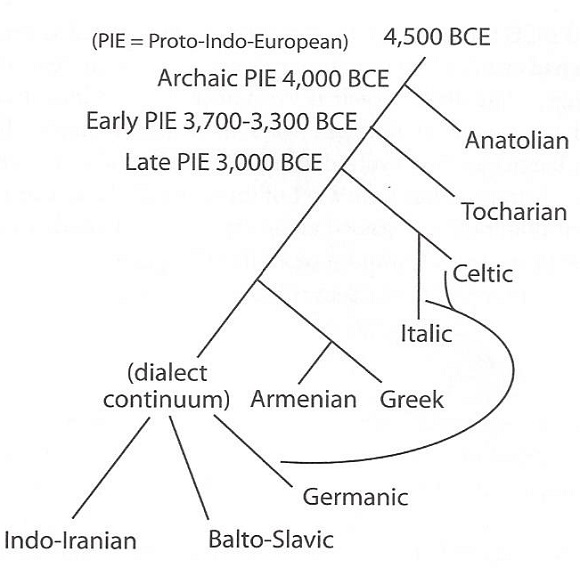
The placement of Germanic is uncertain as it has many characteristic indicating a link with Pre-Italic and Pre-Celtic as well as many shared traits with Pre-Baltic and Pre-Slavic.
A proto-language is “a hypothetical, or reconstructed, typically extinct language from which a number of attested, or documented, known languages are believed to have descended”. In the following the latest dates for some of the main European proto-languages are given:
- Greek 2000-1500 BCE (Before the Common Era, basically BC)
- Italic 1600-1100 BCE
- Celtic 1350-850 BCE
- Germanic 500-0 BCE
- Slavic 0-500 CE (Common Era, approximately AD)
Italic is the mother language of the Romance languages, such as Latin and then Spanish, Portuguese, French, Italian, and Romanian in descending order of the number of speakers.
Slavic languages include Russian, Polish, Czech, Serbian and Croatian amongst others.
Germanic languages include English and German, the Scandinavian languages, Dutch, Afrikaans and Yiddish.
David Anthony’s book formulates a theory which attempts to pin down the time and place where the original Indo-European language developed. Using archaeological and linguistic evidence, especially work done by the Russians which has recently become accessible, he fingers the herders and farmers of the steppes north of the Black Sea. To quote him “west of the Ural Mountains, between the Urals and the Caucasus, in the steppes of eastern Ukraine and Russia.” The following map shows his proposed Proto-Indo-European (PIE) homeland about 3500 to 3000 BCE:
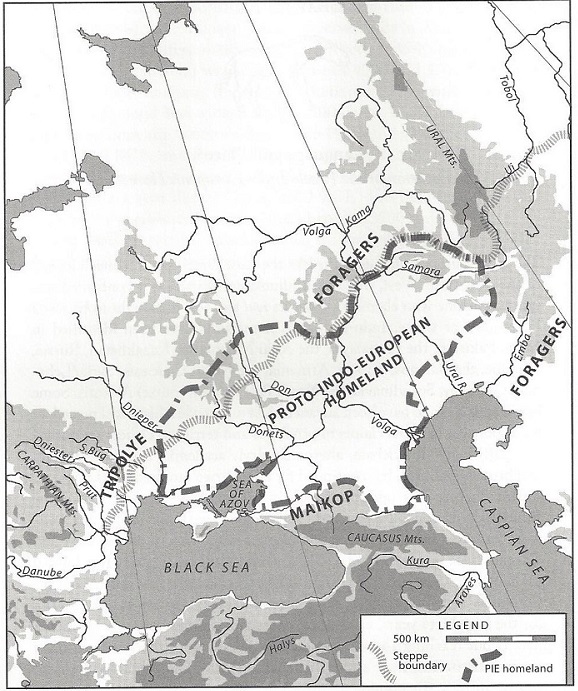
Anthony says there was a distinct cultural horizon at this time between the herders and farmers of the steppes and the forest foragers.
In one sense it’s a refinement of Marija Gimbutas’s 1956 Kurgan hypothesis, except that Anthony has defined the area much more narrowly than the extent of the Kurgan Culture, which can include almost any culture with burial mounds.
He reckons the core time was 4000 to 3000 BCE, with an early phase that might go back to 4500 BCE and a late phase that may have ended around 2500 BCE.
The question arises as to how the language spread so widely.
Previously it was assumed that the culture and populations spread mainly through violent incursions and expansions, where other populations were subjugated or displaced.
Anthony says that the key to understanding language dispersal lies in understanding social relations in what is called the ‘patron-client’ relationship. The chief provides protection, allowing the food producers to get on with their work. More than that, feasts and other social/cultural/religious events and ceremonies led or sponsored by the patron enriched the lives of all and contributed to social cohesion. He points out that when a new chief moved in at the top of a social structure and bettered the lives of the people further down in the hierarchy, then the lower strata readily adopted the language of the chiefs. He cites historical examples of where this has happened in Uganda.
He is not saying that language always spread in this way. He is suggesting, though, that violent displacement, or invasion and subjugation were not the only ways. We’ll have to wait and see whether his theories survive the scrutiny of other experts. The spread of language through trade links and cultural borrowings certainly occurs across cultural horizons, but is completely inadequate in explaining what happened.
There is support for Anthony’s views in linguistic evidence, including the fact that guest and host are cognate terms, as are ghost and the German Geist (spirit).
On the steppes certain inventions and practices came together, not all of them originating in that area. One that did was the domestication of the horse, which Anthony places at about 4800 BCE. He and his wife, Dorcas Brown, did original research on bit-wear in relics of horses’ teeth. Apparently horses back then, as now, literally take the bit between their teeth to alleviate the pain from the pull of the bit on their mouths. This produces bit-wear on the teeth even with corded bits.
Prior to that horses were only hunted for their meat, and a surprising amount (to us) of horse flesh was consumed even after domestication. Riding horses increased herding efficiency enormously, and allowed the quick assembly of fighting manpower, able to scout and strike at a distance. Horses, oxen, the wheel and the wagon allowed herders to operate further out into the steppes, away from rivers and hence less dependent on fish.
Evidence from graves and rubbish dumps shows that goats, sheep, cattle, horses, dogs and pigs were domesticated. Everything but chooks. Certainly, carnivorous feasts were popular, but barley, millet, peas and at least four varieties of wheat were also grown.
The relevant skills of metal-work, pottery, spinning, weaving, felt and leather work proliferated and developed. Minerals were available in the mountains. Use of the plough, the wheel and dairying became extensive in the period 3500 to 3000 BCE.
Cities did not develop, but mound graves of the kurgan cultures show that warrior and chieftain types accumulated great wealth and status.
North of the Caucasus Mountains, they were protected from the cities of the Fertile Crescent, but grew wealthy in supplying the needs of those cities. Anthony says cities were basically cesspools before the Romans invented plumbing and militarily were no match for the power of the chieftains of the steppes.
It seems to me that the country estate as a political form, which lasted in Europe right through into the late 19th century, started back there on the steppes. In time there were larger aggregations, with walled settlements and armies. Anthony says that eventually clients themselves became patrons to other clients in what he calls ‘nested hierarchies’. I guess this is how you got minor nobles owing fealty to counts, barons and dukes who owed fealty to kings.
It’s interesting that the chariot was used in war in the steppes before 2000 BCE, earlier than its use by Roman and Etruscan warriors. Romulus came in late, a mere 753 years BC. Also chariot fighting required a full-time warrior class. It wasn’t a weekend pastime.
It’s interesting too in view of the above that the invasion of England by the Normans in 1066 produced a cultural overlay and linguistic infusion, but the language of the people remained Anglo-Saxon. Perhaps the class divide was just too great to engender comprehensive cultural and social interchange. On the other hand the conquering Franks and Burgundians, both Germanic tribes, resulted in the conquerors essentially adopting the language of the conquered, remembering that Latin was a lingua franca from the Roman imperial days. The development of the final form of modern French is very complex. I understand that in 1789 fully 50% of French people did not speak French as a first language.
I think there is a lot of variety in what happens in each case, so generalisations are difficult. The astonishing fact remains, however, that people from Ireland and Iceland in the west spoke languages derived from the same mother tongue as people do today in much of India and in Sri Lanka (Sinhala but not Tamil).
We speak a Germanic language so it’s interesting to plot the progress of that language. It’s an educated guess, but Anthony thinks the roots of Pre-Germanic languages may have spread into central Europe up the Dniester River to communities further west between the Dniester and the Vistula. The Vistula is mostly in Poland, flows through Warsaw and into the sea near Gdansk (Danzig). The Dnieper is further east and flows mainly through Ukraine and Moldova into the Black Sea at Odessa.
Pre-Germanic would have emerged in this area about 3000 to 2800 BCE. From there communities evolved into the Corded Ware Culture (it’s about rope patterns on pots) on the North European Plain. Finally, Proto-Germanic as a language is thought to have consolidated in what is now southern Scandinavia and northern Germany about 500-0 BCE in the area covered by the Nordic Bronze Age:
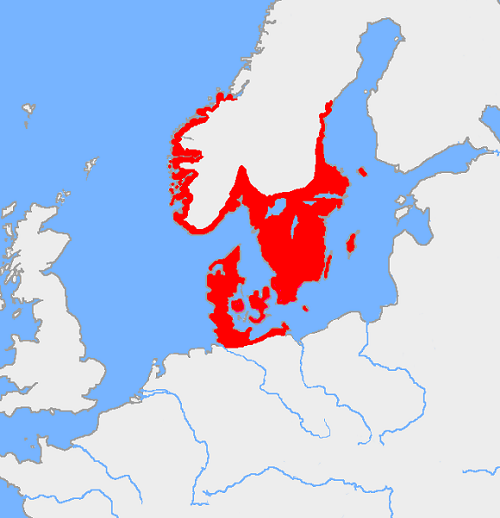
From just before the beginning of the Common Era Germanic tribes moved into main body of continental Europe. At this point we move from archaeology to history. Documents and inscriptions in Germanic languages date from about 0 to 200 CE, giving a higher degree of certainty to our knowledge. At that time the Germans also emerged in the literate culture of the Romans, and, you might say, have been in the news ever since.
The Germans imprinted themselves on the Roman psyche when they ambushed and slaughtered three legions in Teutoberg Forest in 9CE. The Romans returned later, exacted terrible revenge and devastated the local lands, but never thought them worthwhile hanging onto. The Germans were the ‘other mob’.
But they kept coming and this is what the map looked like in the second century AD:
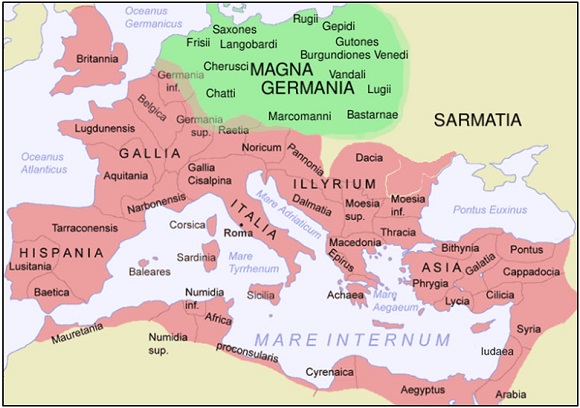
By the 4th century most of the Roman legions were actually staffed by Germans, but over the centuries the German tribes caused a deal of havoc for the Empire. This map shows the main incursions into the Roman Empire up to 500CE:
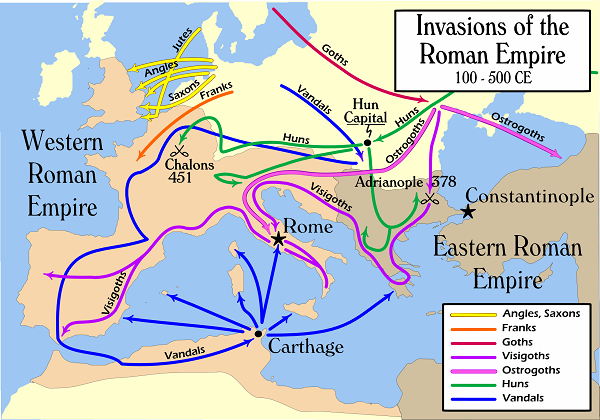
Only the Huns were not Germanic. Rome was sacked three times by Germanic tribes, by the Visigoths in 410 AD, by the Vandals in 455, and by the Visigoths in 546.
That map does not show the Burgundians and the Alemanni, who were already there, or the Lombards who came a bit later to set up a kingdom in Italy.
It must be emphasised that these movements did not result in the displacement or replacement of populations. Norman Davies in Vanished Kingdoms: The History of half-forgotten Europe says that “historians need to take account of the sheer diversity of the ‘barbarians’ and hence the richly polycultural and multi-ethnic flavour of their intermingling with settled populations.”
However, we must leave the continentals there, as East Francia, the eastern third of Charlemagne’s Carolingian Empire, morphed into Germany, became entangled with the Holy Roman Empire and the papacy, atomising into some 360 entities by 1789. Tidying began with Napoleon and arguably finished in 1989-90.
If you follow these maps by the century, Great Britain unified as East Francia/Germany fractured. Norman Davies tells of how originally there were, broadly speaking, Britons (Celts), Western Celts and Picts (also Celts) in the north. These were infused by Germanic tribes in the form of Angles, Saxons and Jutes, and later Vikings and French-speaking Normans. English became and remains a Germanic language, although I understand some 80% of English words have been imported.
More broadly though, the European division of Indo-European later spread through European colonisation and industrialisation.
The central kernel, however, the vector providing impetus from seven thousand years ago, was the patriarchal form of the country estate, which arguably finally gave over to the modern form of the nation state from the end of World War 1.
I’m not arguing that the country estate was good, just successful.
Anthony says that matriarchal socio-political forms gave way to patriarchy whenever herding was introduced, as property was accumulated and needed to be protected. As democracy advanced franchise often was attached to the ownership of property. Anthony as an anthropologist (rather than a linguist, in that particular divide) does have something to say about social relations and culture. I would hope to pick up on those aspects in another piece, sometime, somewhere.
Now you know how I spent Christmas, other than eating, sleeping and polishing my ute.
Update: See also Deep origins: patriarchy January 26, 2018

Brian What a wonderful review. It touches on so many interesting issues including origins of language, the movement of people across Europe and the formation of nations. Another book for me to read!
I am interested at how quickly that English has become the technical language of the European Union. Twenty years ago French was the language of Brussels, now it’s English. Does Anthony provide clues?
You polish your ute? I’m shocked, Brian, shocked.
What a wonderful way to spend Xmas. Fascinating reading, Brian.
Thanks, Paul. I did some of the writing back early in the year when LP was on ice and I was exploring the European origins of our family.
DI(nr), I’ve got a 2006 Falcon, which has great expanses of good paint. The surface was getting quite grimy even after a wash.
Mahaut1329, my piece isn’t a review as such. I don’t cover everything he covered and I go beyond what he covered, if that makes sense. Anthony doesn’t have anything to say about the use of language in the EU that I noticed.
For a review, go to the first link. He spends a lot of time on the contents of graves and rubbish dumps. The review carries this warning:
Actually I don’t think it’s all that easy to skim. You never know when you are going to miss an interpretive nugget.
I think the detail is there in part as a warning to other specialists that he has in fact done the hard yards in exploring the detailed work done by the Russians over some decades.
But while he argues with force, he is also modest, recognising that as more evidence becomes available the overall interpretation may shift. Not by just any sundry expert who breezes in though.
Norman Davies book, essentially a collection of essays, is also an intriguing book.
“Anthony says that the key to understanding language dispersal lies in understanding social relations in what is called the ‘patron-client’ relationship.”
This is really a quantitative not a qualitative question. Thus, rather than provide examples of it happening, you should look at where it doesn’t happen, which, as far as I can tell, was a lot world, including where one country is quite dominant (e.g., China and regions around it — you have regions where there wasn’t much language sharing, and regions where whole new languages were more or less created when they got merged). Perhaps the most common thing that happens is that you get bilingual populations (often with a small part of the population). Possibly the biggest factor is geographical environment, where hills and rough terrain basically protect you from invasion (c.f., trade). This is why the linguistic hot spots of the world are generally in regions where it is hard to invade each other (e.g., PNG, parts of Africa), and why you get large populations which still have their own language, even within countries (e.g., Southern China — and although it could be argued that Cantonese phonology gets more similar to Mandarin more recently, this is really a modern-world phenomena).
You also need to consider the extent of dispersal. If you look at number names across Asia, for example, there is a lot of overlap, but this is a tiny fraction of the language.
One final thing that worries me is this 1000 year rule. There are lots of aspects of language, and you can measure most of them easily. For example, Cantonese and Mandarin are about that distance apart from each other and are pretty similar gramatically excluding phonology (which does change fast). So all we are really learning here is that phonology moves fast. Even Min dialects which are further back are pretty similar gramatically (there are various analyses based on lexico-statistics around of all the Chinese language if you are interested and there is a lot of documentation in terms of when they split from each other).
English is also not a great example to give, because there was the great vowel shift, and so you really did have a big change in the phonology (and you need to be careful about using spoken forms and not written forms), so the changes in terms of time are quite non-linear (so one might almost need to think about things in terms of event-based changes in some cases). There are also many other aspects of English now and older versions not to do with phonology that are still similar.
Thank you Brian #5. I enjoyed Norman Davies’ Europe but have not had a chance to focus on Lost Kingdoms yet.
It is interesting that A thorny is an anthropologist. He will have different perspectives from linguists. As an historian, I see different things again.
One interesting feature of this thread is the fact that Soviet scholarship appears to have survived western academic scrutiny.
This eventuality tends to challenge the supposition in the West that Soviet scholarship was compromised by the demands of towing the party line.
Brian: Languages are about more than exchanging basic information. For example, in the recent past when we were more obsessed with hereditary class our language reflected this. Think posh accents and differences in the grammar used by the upper class compared to coal miners. Think about a more widespread knowledge for terms that tied down how closely we related to people of importance. (How many of us are sure what “second cousin twice removed” means?) It also meant that my wife made a concious decision to switch from her dialect to “educated English as a young teenager. It is interesting to compare the way the current crop of ABC newsreaders talked vs those during WW2.
I am not sure about
I suspect that things like the feudal system thrived when military power depended on expensively armed, well trained fighters riding expensive horses. Ditto, the main source of wealth being associated with agricultural products. Once we got cheap guns that allowed a poorly trained peasant to take out a knight power started to shift towards something more democratic. (My impression was that vikings were relatively democratic because most of them were equally armed and dangerous.)
Katz @ 8, perhaps the party didn’t have a line on what anthropologists were digging up in prehistoric graves and rubbish tips!
Mahaut1329 @ 7, I haven’t read all of Norman Davies’ Vanished Kingdoms. It’s over 700 pages. He brings out important events that might be obscured. One is the Kingdom of Tolosa that existed in Southern France and Spain for 89 years. The cultural imprint in France appears to have been totally erased. Yet if the Visigoth Alaric II, ‘Ruler of All’, had not been defeated and killed by the Frankish King Clovis I in the Battle of Vouillé in 507, the history and map of Europe would have been different.
If a third Germanic tribe, the Burgundians, had not been so busy fighting each other they may have prevailed over the other two. Davies unpicks the 15 or so iterations of the Burgundy state, which most histories and tertiary sources like Wikipedia and Britannica get laughably wrong.
I was also fascinated by his account of what the Teutonic Knights did to the Prusai in what later became the province of Prussia off there in the northeast.
conrad @ 6, Anthony is not really interested in linguistic theory as such, just brings it to bear to answer his big questions.
I realise now that I should have structured the post differently. I should have started with Sir William Jones and his discovery that many Asian and European languages had a common source. Anthony then asks, where was this language spoken, when was it spoken, and how did it disperse so widely, not just as an influence, but as the common language of so many diverse people across what are now geographical and cultural boundaries?
If I’d started with Jones and laid out the questions as an advance organiser the piece would have had a better structure,
The thousand year thing is just an indication to non-linguists that languages in situ change over time for whatever reason so that they become as a foreign language across time. I’m sure no-one is going to die in a ditch over whether it’s always 1000 years. It’s a broad guideline.
BTW I think Anthony makes a fair fist of the where and the when, and offers a further option on the how. The story of how the language dispersed is, I think, quite diverse and complicated in its particularities.
Thank you Brian. I will return to Vanished Kingdoms to enjoy another dip in its waters.
John D @ 9, you’ve perhaps made short work of military history, in which I’m no expert, nor in feudalism. I did a fair bit of reading about Prussia, principally Christopher Clark’s magnificent history Iron Kingdom.
When the Thirty Years War broke out in 1618 Brandenburg-Prussia had no standing army. The war was initially and ostensibly about religious matters after the defenestration of some imperial emissaries by reformists in Prague. The Elector of Brandenburg, being a Calvinist, wanted to enter the war on the reformist side. The mostly Lutheran landed gentry, whose interests were looked after by his Lutheran wife, told him to bugger off. So he was helpless. They controlled the military muscle.
By the mid 1700s the Prussia, now wealthier and better run, had a standing army of 80,000 well-trained men, although they would not have all been Prussian. One did foot soldiering for money back then. But the army would have been run by the Junkers, as was the public administration. Basically the second and following sons of the landed gentry went into the army as officers or the service of the state.
But the country estate still had power within itself. The manorial court could sentence you to death. Clark says in the 18th century this was 16 times more likely to happen in England than Prussia, but the power was there.
Frederick II (“the Great” – 1740-1786) introduced a number of reforms. First he cut off the right of appeal the nobles had to the imperial justice system of the Holy Roman Empire. Secondly, he mandated that manorial judges must be qualified in the law. He also initiated a legal code which was finished after his death.
The law was one thing, what happened in the boondocks another. Clark says that on some estates life proceeded late into the 19th century much as it had 500 years earlier. He also cites a study which found that mid-19th century English peasants had no more freedoms than those in Prussia, with ostensibly more rights by law.
Economically as industrialisation came agriculture, once 95% of the economy, diminished in importance. Here too, however, some industry was established on the estates, hence the Silesian weavers revolt of 1844, where two estates were trashed by starving weavers.
But the Party DID have a say about what was published.
As a check, I’d be interested to make a comparison with archaeology and anthropology journals punished in Germany between 1934 and 1945.
Brian: It would be simplistic of me to over emphasise the importance of changes in relative military power as an explanation of power shifts. Never the less the rise of Cromwell occurred at a point in history when pole weapon wielding commoners could avoid being overwhelmed by mounted royalists. Not the only thing going on but important?
What a delightful farewell gift from Larvatus Prodeo!
Yeah, I’ll go along with the concept of the influence of client-patron relationships. For example: look at what happened to Pictish when the Gaelic-speaking Scots (from Ireland) took over running Caledonia/Scotland.
What makes me sad is the rapid disappearance of dialects and regional accents all over the world – although there are glimpses of hope here and there. For example: the good people of Muenster do pull out their Plattdeutsch (actually, Lower Saxon) dialect for festivals and other occasions.
Katz @ 15: I always found Soviet research – in English – on linguistics and anthropology quite credible and any nods to the Party-line were quite obvious and, therefore, relatively harmless.